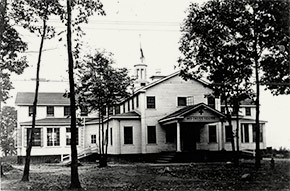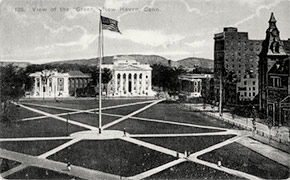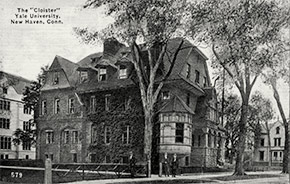Produced by the University of Michigan Center for the History of Medicine and Michigan Publishing, University of Michigan Library
Influenza Encyclopedia
The American Influenza Epidemic of 1918-1919:
A Digital Encyclopedia
New Haven, Connecticut
50 U.S. Cities & Their Stories
On Thursday, September 19, the New Haven Board of Health met in a special session to discuss the epidemic of influenza that was quickly spreading throughout New England. Fourteen cases of the dread malady had just been reported in the city, and, if the experiences of other cities were a guide, more would come. The day before, word had been received from state Commissioner of Health John T. Black that influenza had been made a reportable disease and that all cases should be isolated either at home or a hospital ward and family members quarantined at home, with placards nailed to the doors warning others to stay away. The New Haven Board agreed to comply with Black’s orders and took measures to notify physicians of the new requirements to isolate and report cases of influenza.1
A week later, there were 77 reported cases of influenza in New Haven, all of them in isolation. Yale also reported its first case, a young Student Army Training Corps artillery cadet who became so ill that he had been sent to New Haven Hospital for treatment. There, hospital officials worried about their ability to care for the sick. Already the isolation ward was filling fast, and physicians and nurses were severely taxed. Still, city health officer Dr. Drank W. Wright reassured residents that the situation was not as bad as in other cities. After meeting with state health commissioner Black – an opponent of closure orders unless absolutely necessary – Wright announced that, for the time being, the New Haven Board of Health would take no further action other than to ask the Connecticut Company to keep its streetcars fully ventilated.2
The hospital situation quickly grew worse. On September 30, New Haven Hospital announced that its isolation ward was full. Officials there barred visitors except in cases where the patient was close to death. Other city hospitals thus far had managed to keep influenza patients out of their wards, but that was about to change. Officials at St. Raphael’s Hospital on West Chapel Street, for example, stated that their facility was unequipped to handle influenza cases. With the situation rapidly growing out of control, however, there was little else they could do but to start accepting patients. Similarly, nearby Grace Hospital on began accepting influenza patients as well.3 The naval detachment training at Yale University counted more than 140 cases. The Seaman’s Bethel and Sailor’s Rest on Water Street had to be commissioned as a temporary hospital to care for all the cases. Unfortunately, there were scant nurses to care for the men, and it was several days before a handful of Red Cross volunteers could be found.4 Fortunately, the cases at Yale seemed to be confined mostly to the naval detachment, and not the student military cadets. Nevertheless, the University, led by Secretary Anson Phelps Stokes, quickly closed its gates to visitors, cancelled all campus gatherings, closed its buildings, and asked the military to discourage sports games.5
Wright worried that naval cases were filling too many of New Haven’t hospital beds, leaving precious few for the city’s civilian influenza cases. Hospital administrators assured him that they would accept civilian patients as well, but what of the shortage of nurses? The situation across the state had grown so critical that Connecticut Commissioner of Health Black issued an urgent appeal for all available nurses and physicians to register with his office and to prepare themselves for deployment when and where necessary. He also worked with the State Council of Defense to furnish a volunteer automobile corps for ambulance service. In New Haven, the local chapter of the Automobile Club pitched in to provide vehicles and drivers.6 The health department directed its ten school nurses to home nursing assignments, particularly for the needy.7 Working the other side of the dread epidemic, undertakers were pressed to keep up with the demand for their services. Coffins were in desperately short supply, and one exasperated undertaken complained that he only had a two-week inventory of caskets on hand. Another moaned that the work was too much to handle.8 Physicians were so overtaxed that there were not enough available to conduct physical examinations of the city’s military draftees. The exams scheduled for October 8 and 9 had to be cancelled.9
Schools were also affected. The Board of Health Superintendent of Schools F. H. Beede reported twenty percent grade school absenteeism and ten percent absenteeism in the city’s high schools. Despite the worsening influenza situation, health officials were determined to keep public places open as long as possible, arguing that there was little sense in causing social and economic disruption unless closure orders were proven effective. On October 7, state health authorities sent Wright a letter asking him to keep schools and theaters open while continuing to educate the public as to proper ways to prevent and treat influenza.10 Wright agreed and pressed to keep schools open, citing that students were safer in their classrooms where they could be monitored by school nurses and physicians rather than out in the streets. He also believed that selective closures of particular public places were useless, and that a more sweeping closure order would be impossible to enforce. Better, he argued, to keep sick children and those coming from houses with influenza out of schools and to let the rest of the population carry about as usual.11
On October 14, as 264 new influenza cases were added to the list ill residents, the Board of Health met in emergency session to discuss the epidemic. Its decision: to prohibit “promiscuous indoor public gatherings,” such as dances and parties. Soda fountains, restaurants, and similar establishments were ordered to sanitize their utensils thoroughly. Theaters and movie houses were given strict orders to maintain proper ventilation and to exclude patrons exhibiting symptoms of colds. The order also formalized strict expectations for proper ventilation in theaters and movie houses and the exclusion of patrons with colds, as several establishments had been ignoring these measures when they were merely voluntary. Mayor David Fitzgerald endorsed the Board’s measures, stating that all violators risked closure of their establishments if they refused to comply. He directed New Haven’s police force to enforce the directive.12 A week later, on the evening of October 20, Wright undertook a personal tour of movie houses on observe attendance and to check on conditions in the buildings. He found that theater managers, eager to avoid mandatory closures, had done a good job of ensuring adequate ventilation for patrons as well as using lantern slides to educate them on the dangers and treatments of influenza.13
Others urged prevention tactics as well. Professor C.E.A. Winslow, Dean of Yale’s School of Public Health, volunteered his services to the Health Department and began an inspection of New Haven’s factories, offering advice to supervisors on how to prevent infection. Milton Winternitz, a pathologist and future dean of the Yale School of Medicine, worked with a corps of assistants to vaccinate nurses at New Haven Hospital before moving on to employees at the Winchester firearms factory. Between October 10 and October 19, Winternitz and other members of Yale’s Brady Laboratory, where the vaccine was developed, administered 1,200 doses, though evidence was still forthcoming on the serum’s effectiveness.14
By the end of October, the influenza epidemic showed a slight decline. School physicians and nurses had examined some 9,000 of the city’s 29,000 schoolchildren, clearing them for admittance. In the last days of the month, approximately one-third of children were reported to be absent from their classrooms, either as a result of illness or because someone in their families was ill. Teacher absenteeism, once very high, was reported to have fallen to 25%, although Superintendent Beede added that it was still very difficult to secure substitutes. Wright urged teachers to get vaccinated by the Yale serum in order to protect them. He also asked them to consider becoming volunteer health workers in the event schools closed.15
The volunteers were not necessary. School officials reported that school absentee rates were approaching normal. Theaters also reported larger attendance, although whether due to reduced illness or less anxiety about influenza amongst New Haven’s well it was impossible to say.16 In fact, all across Connecticut the epidemic had died down enough that the federal Public Health Service physicians sent there to lend their services were transferred to Pennsylvania, where the epidemic was still raging.17
There were some hiccups, however. As the epidemic dwindled, Wright ordered that all teachers and students who had been absent for any disease would be required to undergo a medical examination at the Department of Health before they could receive a certificate of reentry to school.18 The plan, simple enough in outline, produced uproar. First, the Department of Health building could not accommodate the number of students (and their accompanying parents) requiring examination. On October 28, the very first day of the examinations, physicians were swamped with children, who quickly crowded the narrow corridors of the municipal building and then spilled onto the chilly sidewalks outside. Many were not quite over their ailments and still had the sniffles, posing a danger to their own health and possibly that of others in line. The next day, the health department erected a tent downtown on the green for the examinations, but this only made matters worse. The crowding continued, but now everyone waited outside while an estimated 9,000 children were exposed to the damp, chilly autumn weather. The situation aroused community-wide indignation and put Health Officer Wright and Superintendent Beede on the defensive. Quickly, they dismantled the tent and resumed examinations in the police building.19
As October rolled into November, New Haven’s epidemic situation had improved so much that the local newspapers hardly took note of it anymore. The only hotspot in the city was St. Francis Orphan Asylum. The orphanage had closed its doors to the outside work on October 1 as a way of protecting the 464 children, sisters, and staff. Only the school supervisor was allowed to enter. The gambit worked for two months straight, until, finally, on December 10, a staff member grew ill. From there, the infection exploded. By January 7, there were 424 cases and seven deaths. Of the stricken, 398 were children, prompting Mayor Fitzgerald to issue a broad appeal for help.20 Community physicians rose to the occasion, and the Red Cross rushed volunteer nurses to the scene, some from as far away as Boston and New York. In New Haven, the Elks coordinated food donations and recruited other volunteers, including teachers and women helpers serving as aides, housekeepers, and cooks.21 Finally, by the end of the first week of the new year, the asylum had come out the other end of the ordeal. With these last remaining cases on the mend, life slowly returned to normal in New Haven.
Conclusion
Influenza continued to infect and affect New Haven residents throughout the winter of 1919, but the danger had largely passed. Overall, the city had suffered a significant epidemic, although one not as severe as several of its New England counterparts. New Haven’s epidemic death rate was 587 per 100,000 people. By comparison, Fall River, Massachusetts, 120 miles up the coast, experienced an excess death rate of 621 per 100,000 people. Worcester experienced a death rate of 655 per 100,000 people, while Boston’s death rate was a staggering 710 per 100,000 people. On the other hand, cities such as Lowell (523 per 100,000), Cambridge (541 per 100,000), and Providence (574 per 100,000) fared better. Yet New Haven was one of only three major American cities (New York City and Chicago were the others) not to close its schools during the epidemic, leading to less social dislocation during the crisis.
Notes
1“Acts Quickly to Curb Influenza,” New Haven Journal-Courier, 20 Sept. 1918, 1.
2“Influenza Cases Show Increase,” New Haven Journal-Courier, 26 Sept. 1918, 4; “Influenza Nears Epidemic Stage,” New Haven Journal-Courier, 30 Sept. 1918, 1.
3“Officials Confer about Influenza,” New Haven Journal-Courier, 1 Oct. 1918, 14.
4“Epidemic Assumes Serious Aspects,” New Haven Journal-Courier, 3 Oct. 1918, 1.
5“Naval Men Hard Hit by Epidemic,” New Haven Journal-Courier, 4 Oct. 1918, 1; “Report Decrease in ‘Flu’ Cases,” New Haven Journal-Courier, 5 Oct. 1918, 1.
6Connecticut Department of Health, Thirty-sixth Report of the State Department of Health for the Two Years ending June 30, 1920, John T. Black, M.D., Commissioner (Hartford: State of Connecticut, 1920), 301-306.
7New Haven Department of Health, Annual report of the Health Department of the City of New Haven, Connecticut, for the year ending December 31, 1918 (New Haven: 1919), 28-29.
8“Influenza Takes big death Toll,” New Haven Journal-Courier, 14 Oct. 1918, 1; “Schools Close as Flu Gains in Violence,” New Haven Evening Register, 15 Oct. 1918, 1.
9“Call Off Draft Exams because of Influenza,” New Haven Evening Register, 7 Oct. 1918, 1.
10“160 New Cases of Spanish Grippe,” New Haven Journal-Courier, 8 Oct. 1918, 1.
11“Influenza Reaps Big Human Toll,” New Haven Journal-Courier, 11 Oct. 1918, 4; “Drastic Order by Board of Health,” New Haven Journal-Courier, 15 Oct. 1918, 1.
12“Drastic Order by Board of Health,” New Haven Journal-Courier, 15 Oct. 1918, 1.
13“Little Change in Local Epidemic,” New Haven Journal-Courier, 21 Oct. 1918, 3; New Haven Department of Health, “Monthly Bulletin Containing the Report of Health Officer and Mortality Statistics for the Previous Month,” vol. XLV, no. 12 (December 1918), 3.
14“Influenza Takes a Slight Slump,” New Haven Journal-Courier, 16 Oct. 1918, 1; “Vaccination against Flu Begun Here,” New Haven Evening Register, 17 Oct. 1918; “Serum May Halt Spread of Flu Here,” New Haven Evening Register, 19 Oct. 1918, 1.
15“155 New Cases and 4 Deaths in Flu Wave,” New Haven Evening Register, 22 Oct. 1918, 1; “Schools are affected,” New Haven Journal-Courier, Oct. 29, 1918, 9.
16“Epidemic Shows Slight Decline,” New Haven Journal-Courier, 29 Oct. 1918, 16; Lack Substitutes in City Schools,” New Haven Journal-Courier, 28 Oct. 1918, 6.
17“5,577 Die in State,” New Haven Journal-Courier, 4 Nov. 1918, 5.
18“Believe the Crisis Is Past in Epidemic,” New Haven Evening Register, 23 Oct. 1918, 1.
19“Pupils Swamp Health Office for Permits,” New Haven Evening Register, 28 Oct. 1918, 1; “Health Officials Hit for Method in Granting Children Permits,” New Haven Evening Register, 29 Oct. 1918, 1; “Health Board Abandons Its Tent on the Green,” New Haven Evening Register, 30 Oct.1918, 1.
20New Haven Health Department, Annual Report of the Health Department of the City of New Haven, Conn. For the year ending December 31, 1918 (New Haven, 1919), 29.
21Connecticut State Department of Health, Thirty-sixth Report of the State Department of Health for the Two Years Ending June 30, 1920, John T. Black, M.D., Commissioner (Hartford: State of Connecticut, 1920), 306-307; “Victim of Influenza,” New Haven Journal-Courier, 2 Jan. 1919, 4; “Nurses Needed to Fight Epidemic,” New Haven Journal-Courier, 4 Jan. 1919, 1.








